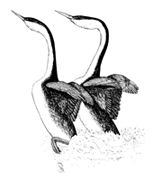Papers in the Biological Sciences
Date of this Version
April 1987
Document Type
Book Chapter
Abstract
It is now well recognized that, like behavior, a species' life history characteristics, such as age at sexual maturity, clutch sizes, and incubation, brooding, and fledging patterns, are evolved traits that may be strongly influenced by a variety of ecological factors. Within the auks, loons, and grebes one can find variations in the age at sexual maturity and time of first breeding ranging from as little as 1 to as many as 5 or 6 years, average clutch sizes that range from 1 to 4 eggs, and substantial variations in adult survival rates and maximum longevity. However, compared with such similar-sized aquatic birds as ducks and geese, all three groups tend toward relatively small clutches, a greater tendency to defer sexual maturity and breeding, and substantially higher adult survivorship rates and thus potentially greater maximum longevity. In general such characteristics are associated with groups of birds that breed under relatively difficult conditions, where age and experience probably are significant factors influencing breeding success and for which, therefore, it is advantageous to the species to limit reproductive efforts to older individuals, who are most likely to be successful. In these three groups all the species are exclusively monogamous, with both sexes participating in incubation, brooding, and to varying degrees in feeding the young, which though generally precocial cannot capture prey on their own until they are relatively well developed.



Comments
From Diving Birds of North America (1987) by Paul A. Johnsgard. Copyright © 2007 Paul Johnsgard. Cite this work as: Paul Johnsgard, Diving Birds of North America (Lincoln, Nebraska: University of Nebraska Press, 1987; University of Nebraska–Lincoln Libraries, 2008 [ebook edition]).